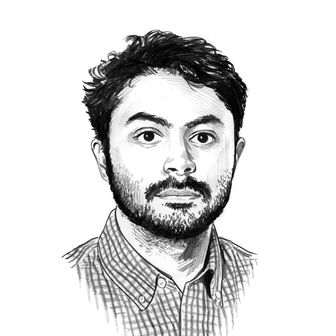
Every Wednesday in August, Vulture will choose a film to watch with readers as part of our Vulture Movie Club. This week’s selection comes from Vulture editor Eric Vilas-Boas, who will begin his screening of Vampire Hunter D: Bloodlust on Wednesday, August 21, at 7 p.m. ET. Head to Vulture’s Twitter to catch the live commentary.
In Latin, animātiōn may mean the “bestowing of life,” but in Vampire Hunter D: Bloodlust, it delivers ecstatically drawn death. In the film’s first shot, a monumental moon presides over a decrepit castle and a cobblestoned, cross-laden town. We don’t immediately see the demon that rides through the streets, but the camera tracks his lethal progress: He leaves flowers desiccated and fountains frozen in his wake before spreading sinewy wings and spiriting a maiden from her bed.
That opening teases the rest of the film’s style. Unlike the original 1985 Vampire Hunter D — a low-budget, direct-to-video effort — 2000’s Bloodlust is opulently produced, a postapocalyptic action epic stuffed with black leather, red lips, and supernatural bloodletting. It’s brutal but also sexy as hell, like many of the defining entries of the goth cinema canon. It’s also, weirdly, still underappreciated. Its director, screenwriter, and storyboard artist, Yoshiaki Kawajiri, isn’t nearly as celebrated in the United States as his peers Hayao Miyazaki or Mamoru Oshii, but his films are arguably as influential. Bloodlust is his finest work, one of the last great features from anime’s seductive video-store era that Kawajiri’s ultraviolent titles like Ninja Scroll and Wicked City helped shape.
Bloodlust is approachable by design, an adaptation of author Hideyuki Kikuchi’s Demon Deathchase novel in the ongoing D saga. After that opening sequence, we meet the anti-hero D, a half-vampire-half-human bounty hunter, who takes on a contract to rescue the maiden from her vampire captor, Meier Link. That mission gets complicated once other bounty hunters join the chase and we learn that the victim, Charlotte, is actually in love with Meier. Along the way he tangos with rival bounty hunters and powerful demons — including one naked, reanimated zombie vampire queen drenched in approximately a hogshead of blood. Like the spaghetti westerns that influenced it or its spiritual cousin Mad Max: Fury Road, Bloodlust’s plot is simple but never boring. It’s essentially a two-hour chase, and Kawajiri’s visuals are always the focus.
That starts with the characters. We often see D framed in the distance, a lone figure in a barren landscape. Originally designed by Yoshitaka Amano and translated to the film by Yutaka Minowa, D is a slender, soft-spoken swordsman dressed perpetually in black — as if Timothée Chalamet were spliced with Yojimbo and given a massive wide-brimmed chapeau. D is canonically “gorgeous,” according to the books. His dhampir parentage (“dunpeal” in the bowdlerized English dub) means he is shunned and feared by society; ergo, even hotter. His goth beauty is underscored by a belt, sword hilt, and horse saddle adorned with matching skulls. In almost every shot, his face is obscured in shadow, and we almost never see both of his eyes open at the same time.
His supporting cast offers contrast but never ugliness. Next to D’s Timothée, Meier is giving a pale-blue Sting from the original Dune — Byronic menace and agonizingly edged sexual desire, plus spiky swept-back hair, jewelry, and a winged demon form. Meier doesn’t want to damn Charlotte to a vampire’s existence; he adores her. When he’s not caressing her body, he’s risking oblivion by walking into burning sunlight for her. Charlotte’s wardrobe is stocked with corsets and flowing Victorian lace, her neckline perpetually exposed. The gun-toting bounty hunter Leila’s design delivers a different kind of femininity: She wears lipstick and heels but also armored shoulder pads, and she carries a gigantic pistol and a telescoping bazooka that she fires from atop a motorized unicycle. Even the gruesome monsters — a scantily clad tree demon, a werewolf with a gnashing mouth popping out of his chest, a bounty hunter who shoots up drugs and astral-projects an exploding ghost — are polished to perfection. None of these designs are as soft as something you’d see in a Studio Ghibli movie, but that isn’t the point. They look fine as hell in the context of Kawajiri’s dark world.
In spite of its dynamism, enthralling visuals, and obviously high production value, Bloodlust’s theatrical take capped out at $151,086 in the United States, across just 12 theaters. The story goes that the unusual choice to distribute the film in the States first was a bet by veteran producer Mataichiro Yamamoto that action anime could work on the big screen in North America. Vampire Hunter D: Bloodlust was animated by Madhouse in Japan, but its final print was mastered under the California sunshine, at Skywalker Ranch. Unlike most Japanese anime, its original audio track is the English one. Yamamoto’s Urban Vision Entertainment eventually went out of business, but with Bloodlust, he was ahead of his time. The film arrived before Miyazaki won his Oscar for Spirited Away, before channels like Adult Swim imported mature anime, and many years before GKIDS started earning acclaim for its packaging of international animation releases. Bloodlust’s underwhelming release proved a melancholy fate for a film about beings doomed to lust eternally but never to live or be understood.
Bloodlust has long been a home-video favorite among anime fans, most recently thanks to the Blu-ray sellers at Discotek Media, though it’s not (legally) available to stream. For those hoping for a wider re-release, a distributor like GKIDS or the streamer HiDive may hold the most promise: The lattter is sending Kawajiri’s Ninja Scroll to over 500 U.S. theaters in September. Until Bloodlust’s day comes, some of you might find it on the Internet Archive or other dark corners of the Internet where unlicensed anime persists. Like its demonic specters, Vampire Hunter D: Bloodlust endures in the dark, safely packed in boxes available for purchase and waiting for unsuspecting lovers to savor its unearthly delights.
More From This Series
- No Movie Captures the Essence of Neil Young’s Best Songs Like Inherent Vice
- Without Brandon Lee, The Crow Doesn’t Fly
- Signs Is the M. Night Shyamalan Experience at Its Best



